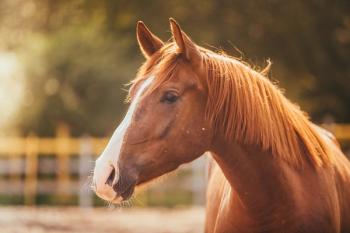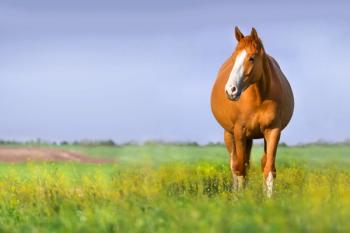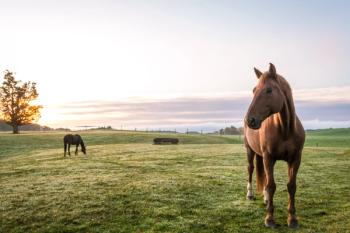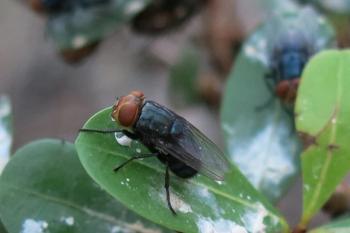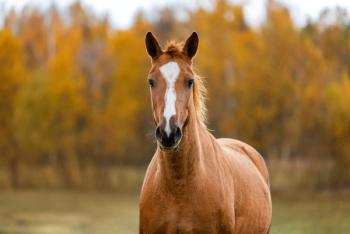
Hydration 101: You can lead a horse to water and make it drink
Slightly hypertonic water will stimulate the thirst center, impelling a horse to drink more overall water.
It happens innocently enough. A healthy, seemingly fit horse is competing at a local horse show on a hot, humid summer weekend or participating in a 25-mile competitive trail ride or perhaps simply working cattle as part of a regular day. It has been hot all week, but the horse has had access to plenty of water and even had a salt block available. The horse has been sweating heavily all morning, but its owner made sure to take numerous breaks to offer it water. Even though it hasn't shown much interest in water, the owner is certain his horse will drink when it needs to, so they continue to ride or jump or work.
Water is 20 times more efficient than air at cooling a horse. The proper method to use is spray (or sponge), scrape and repeat.
Meanwhile largely unnoticed metabolic and physiologic processes are occurring that soon can make this equine athlete an emergency situation that you will have to deal with. Research has shown that during a 50-mile endurance ride in ambient temperature, the average horse will do enough muscular energy and produce enough heat to melt a 150-pound block of ice and then bring it to a boil. At a temperature rise of almost 2 degrees F per hour (without sweating) a horse would soon reach the critical temperature of 42 C, and a crisis would ensue. The need to remove this heat from the performing/working horse is crucial.
Horses lose heat through evaporative cooling, utilizing sweat and through respiration. About 1.5 to 4 gallons of sweat can be lost each hour during strenuous work in hot conditions. Add slowly progressing dehydration to this picture, and the athletic horse begins a dangerous process that, if not altered, can result in heat stress, heat stroke and possible death. The horse working on a hot day in our example is beginning to become dehydrated. Usually dehydration causes the plasma sodium (Na) concentration to increase, and this rise in sodium is a trigger for the thirst response in horses. However if a horse is becoming systemically dehydrated but is also sweating heavily, then the overall loss of Na in the sweat can offset the drop in plasma volume, and the sodium concentration can stay the same or actually increase. Horses in this situation are losing significant electrolytes and are beginning to experience hydration problems, but they might not be thirsty and might not drink when water is offered. It is important to stress to owners that all exercising horses must drink even if they don't appear to be thirsty.
Even though the old saying goes: "You can lead a horse to water but you can't make him drink," a good number of endurance and event riders will tell you differently. Horses that will be exercising heavily in heat and humidity must be taught to drink at every opportunity — especially during the early stages of exercise.
DVM Newsbreak
Dr. Harold Schott and researchers at the Veterinary Medical Center at Michigan State University have shown that offering horses slightly hypertonic water (0.9NaCl) during exercise will stimulate the thirst center and will result in that horse drinking more overall water than if non-salty water had been used. Their research would also support offering exercising horses water at ambient temperature because experimental horses drank more water at room temperature than either warmer or cooler water when offered. The consequences of dehydration are far too serious to ignore possible ways to encourage horses to drink.
Once dehydration begins to take place, the horse's body loses the ability to sweat efficiently. Without enough sweat, the horse cannot continue to utilize evaporative cooling to dissipate the heat that it is still producing. As the body dehydrates, there is a loss of plasma volume, so blood becomes less fluid. The cardiovascular system becomes less efficient at transporting oxygen throughout the body, and it must begin to work even harder to support the working horse.
Dr. Susan Evans Garlinghouse, writing in Endurance News, a publication of the American Endurance Ride Conference, reports that studies show that a horse that canters has a heart rate of 130 beats per minute when fully hydrated, but a dehydrated horse can achieve a heart rate of up to 160 beats per minute doing the same level of athletic work. Thus, the athletic horse must work harder when dehydrated, which further increases the heat being produced, and a vicious cycle gets worse. Such a horse is increasing the effort of work but functioning less efficiently. The body responds to such a crisis by beginning to shunt blood from less-vital organs. One of the first systems to show a reduction in blood flow is the intestinal tract. Many horses begin to experience intestinal cramps in conditions of electrolyte imbalance and dehydration, and ileus and colic are common consequences. Often these complications are seen at a time that can be far removed from actual work or competition. It is important that owners remember to continue supplementing their horses with electrolytes and encouraging water intake for days after heavy exercise so the horse's body is given ample time to rebalance itself.
Recommendations for the prevention of hydration problems in performance horses are simple to give but much more difficult to encourage horse owners to follow.
During the week before competition, ensure that the horse has a high-quality diet that includes added electrolytes. While electrolytes cannot be "stored" in the body, you do want to ensure that all the horse's body needs are being met and that no deficiency situation exists prior to athletic work. Utilizing a high-fiber diet in the days prior to competition also will create a reservoir of soft, wet ingesta in the gut that can be used as a source of both water and electrolytes early in a competition when horses normally show poor inclination to drink. Horses working at speed over short distances might not wish to carry the added weight of a large volume of wet ingesta, so an alternative approach might be needed.
There are countless formulations of electrolytes available, and it can be beneficial to analyze blood samples taken before and after a competition in hot, humid conditions to determine the very best electrolyte mixture for each specific horse. During competition, a dose of these electrolytes can be given orally every two hours. Be sure to have clients buffer these electrolyte mixtures because high salt formulations can be irritating to the mucosa of the horse's mouth and tongue.
Keeping a horse hydrated is not exceedingly difficult and the physiology of heat stress is not difficult to follow. Yet each summer veterinarians will deal with a number of such cases. Prevention comes from education, so encourage your clients to learn the facts about heat stress, fluid loss and electrolyte replacement so they can graduate with honors from Hydration 101.
Newsletter
From exam room tips to practice management insights, get trusted veterinary news delivered straight to your inbox—subscribe to dvm360.


